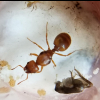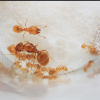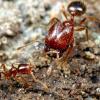I caught this queen today, under a large stone, just a few feet from a creek, and at first thought she was usual niger group, until I saw here brilliant orange legs, and a slightly yellowish underside of her gaster. This species has been a dream of mine since I started getting into the hobby two years ago. So, as you can imagine, I was estatic when I found this queen. Here are two pictures: 

Edited by NickAnter, April 3 2022 - 8:47 PM.
-
CatsnAnts, AntsDakota, Antkid12 and 2 others like this
Hi there! I went on a 6 month or so hiatus, in part due, and in part cause of the death of my colonies.
However, I went back to the Sierras, and restarted my collection, which is now as follows:
Aphaenogaster uinta, Camponotus vicinus, Camponotus modoc, Formica cf. aserva, Formica cf. micropthalma, Formica cf. manni, Formica subpolita, Formica cf. subaenescens, Lasius americanus, Manica invidia, Pogonomyrmex salinus, Pogonomyrmex sp. 1, Solenopsis validiuscula, & Solenopsis sp. 3 (new Sierra variant).






















